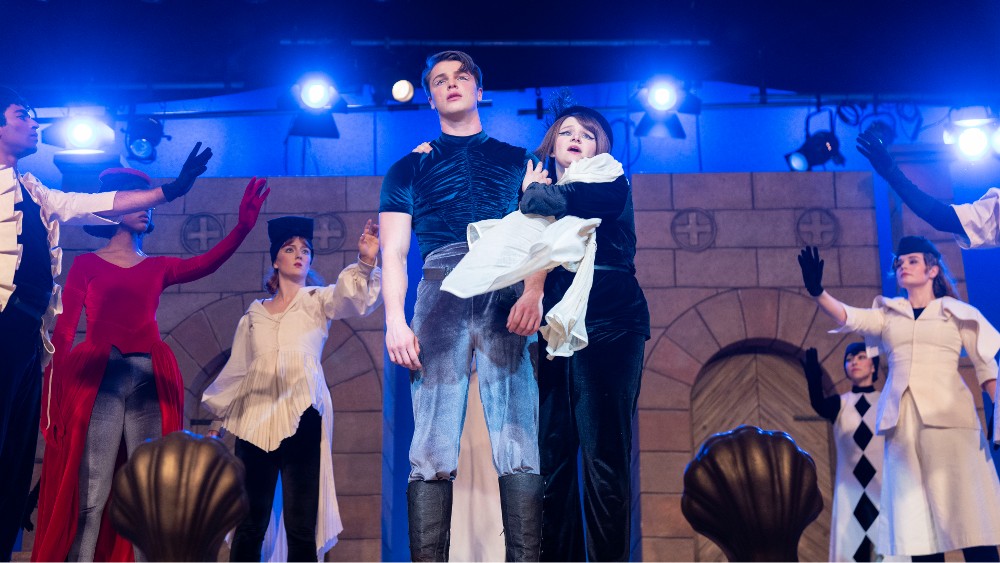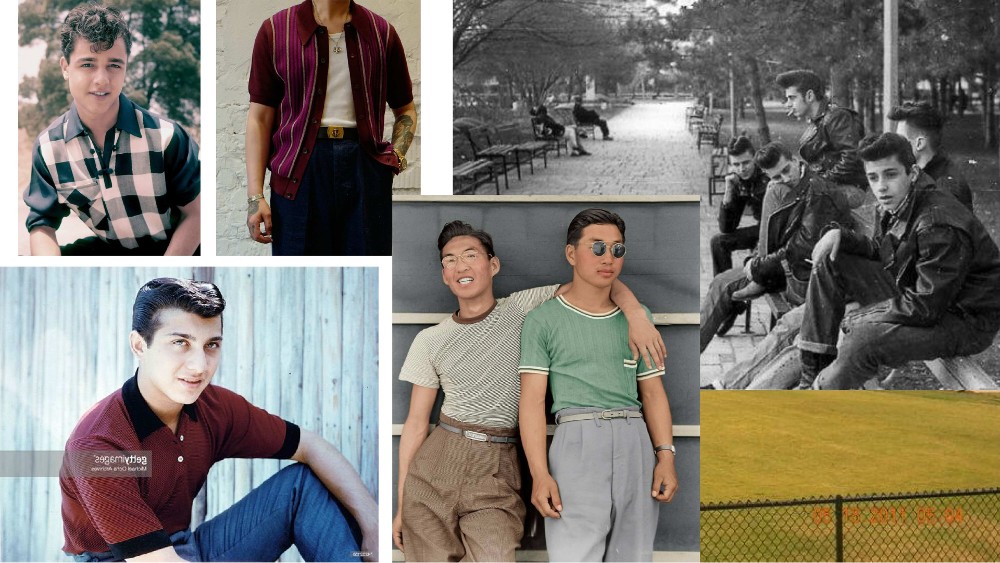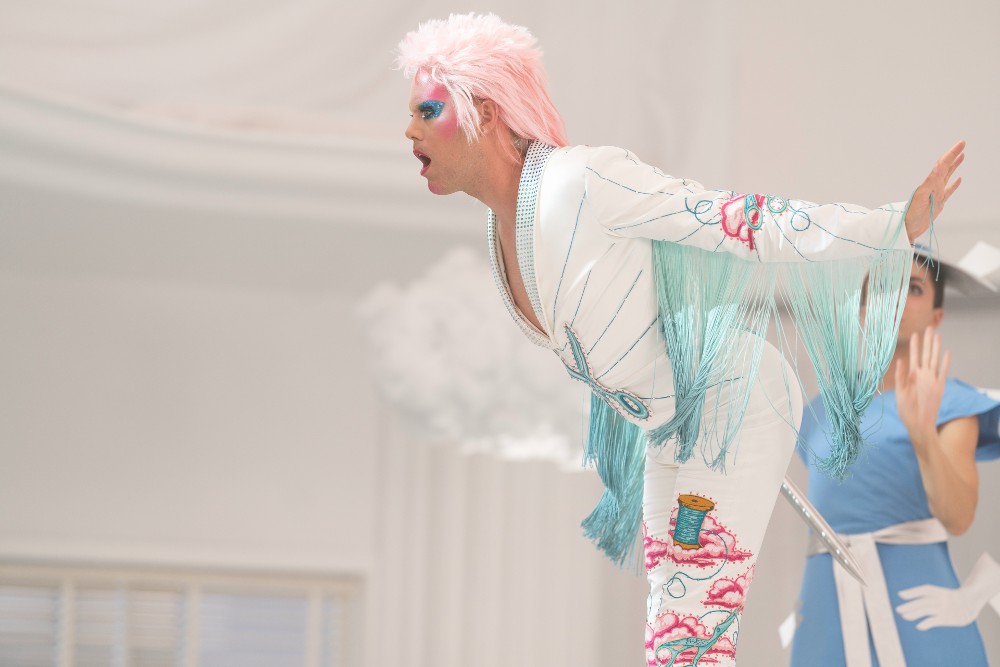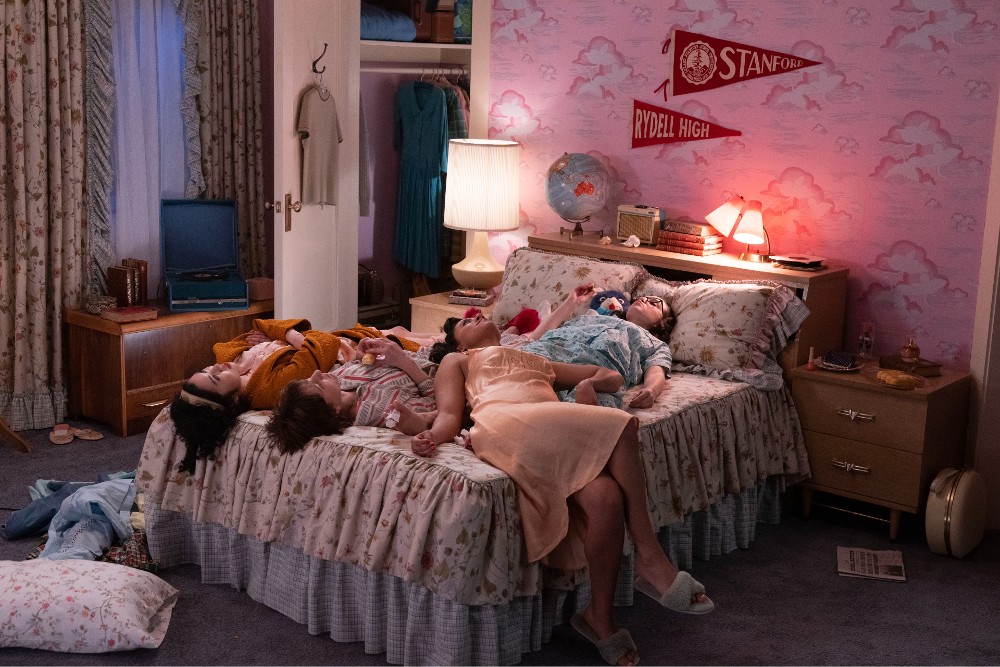
It was 1978, and Grease was certainly the word, starring John Travolta as T-Birds leader and bad boy Greaser, Danny Zuko, who crooned his way into the heart of sweet and innocent Sandy Olsson, played by Olivia Newton-John. It worked, as she swiftly was revamped into a pink lady. The spin-off musical series Grease: Rise of the Pink Ladies (Paramount +) is a prequel, if you will, to how the good girls of Rydell High acquired their hot pink jackets emblazoned with the logo “The Pink Ladies.”
It’s still the 1950s, where good girls fend off their teenage hormones. Enter the Pink Ladies, young women who own their sexuality and who rise up to flaunt it. Their poodle hoop skirts become sleaker and tighter with slits up the back, but they haven’t traded in their Barbie socks with black and white saddle shoes for heels just yet. Costume Designer Samantha Hawkins, who joined the series on Episode Four, embraced her love of character and story to design the clothes for the T-Birds, the Pink Ladies, the cheerleaders, and the teachers of Rydell High.
Born and raised in Ohio, Hawkins works on projects with strong storytelling, whether in indie films like The Ultimate Playlist of Noise, I Want You Back, and The Night House or television projects such as Trigger Warning for Netflix and Big Time Adolescence for Hulu.
Below The Line spoke with Samantha Hawkins via Zoom video from her home in Los Angeles. She talked about revisiting the film Grease for inspiration and a random connection with another classic film, Rocky Horror Picture Show, that would play a part in her career beginnings.

Below The Line: How did you get your start in costume design?
Samantha Hawkins: I went to college at Kent State University, where I studied fashion design. They have a really good program, like fourth in the nation or something, but I sort of fell into costumes a little bit randomly. When I moved to New York, I went to a Rocky Horror Picture Show where they do the live cast with friends, and I became friends with some of the cast, and one of them asked me to design a music video for him that he was doing. I made around 40 cardboard robot costumes in four days. His name is Felipe Dieppa, who was the voice of the boy in Dora, the Explorer. Now he’s a producer, but he randomly got me into costumes.
BTL: So that random meeting set you off on your illustrious career, and now here you are designing costumes for Grease: Rise of The Pink Ladies. Did you go back and watch the original Grease film for inspiration?
Hawkins: Yes, I did. It wasn’t a movie that I was obsessed with as a kid. I know a lot of people were, and I liked it fine, so I watched it again and was actually so blown away by the costumes. The palette of the whole movie is incredible. Of course it’s (costume designer) Albert Wolsky (All That Jazz), so that makes sense. It’s also really funny because one of the first jobs I’ve ever had was as a costume PA for Albert, so it was so full circle. But watching it again was incredible—just the grounded neutrals throughout. I struggle with musicals sometimes that are too saturated, too bright, or it’s all pastels or something, and there’s no brown or gray to ground anything. I think Grease does that beautifully.
BTL: So what was the color palette in this show?
Hawkins: We wanted to sort of do the same thing and keep the colors grounded. It’s very bright. There are tons of characters. With the number of people on the screen, it is sometimes chaotic. It’s definitely a hard line to walk when showing off your main characters, but the background is also hilarious in the show, and they have all their little quirky moments happening behind the scenes. So, you also want to see them. The palette is kind of all over the place, and it’s also dependent on the episode and the musical number we’re doing. It changes, so it’s an ongoing discussion.
BTL: For example?
Hawkins: I had all the scripts, a lot of them written, and if they weren’t written, they were outlined, so even when I was interviewing, I could see the trajectory, which was nice. Then once I got into the show, we did a concept meeting first where everyone read the episode, and then we heard from the director and the showrunner about what they were wanting, and they’d talked about the musical numbers, so they were sort of feeling them out.
Then I get their notes on what they’re thinking, like in episode four (“If You Can’t Be an Athlete, Be an Athletic Supporter”), Olivia’s (Cheyenne Isabel Wells) number, when she’s in the green knit set and then it goes into that black and white classroom, was an idea brought forth by the episodes’ director. It wasn’t really in the script.
When you have these concept meetings, ideas are thrown around. When she sort of mentioned that idea, then it was like, “Oh, then we gotta do black and white uniforms on the boys, and her color needs to really pop.”

BTL: Do you create mood boards for your ideas?
Hawkins: I hone in on all my ideas for the episode, and I create boards of my ideas, the reference images, the research images per character, and the musical numbers. I have a meeting with all the head honchos. They have notes, and then I present those to the team within a couple of days because we only have two weeks to prep an episode. It’s really fast.
BTL: Let’s break it down to the four lead girls. They start out looking completely different than they do as Pink Ladies. How’d you want them to grow from start to finish?
Hawkins: It was really fun to embrace their character growth and show that in the costumes. You know, Nancy’s (Tricia Fukuhara’s) looks get more outrageous as she just really leans into her fashion stuff. I call her my drag queen. All of her looks are on theme. Cynthia’s (Ari Notartomaso’s) looks really change as they are figuring out who they are. What was also fun is that a lot of these characters are 16 or whatever, so they’re finding themselves. Cynthia doesn’t have access to the clothes that she would prefer to wear, like at school, where she can’t wear pants and stuff like that. So, it’s also showing that they don’t always get to wear what they want to wear, and finding that and walking that line is fun.
Olivia is sort of coming into her power, and she’s been sexualized, but she’s also now owning that, taking power from that, and doing what she wants rather than feeling like a victim to that. Jane (Marisa Davila) is this people-pleaser who has to figure herself out. She’s always torn between parents and friends, or Richie (Johnathan Nieves) and Buddy (Jason Schmidt). For me, she’s like the best friend in any other show who doesn’t realize she’s the leading lady, and on this journey to figure out that she’s the leading lady in a way.
BTL: Where did you source the ’50s style clothes?
Hawkins: A lot of our shoes came from vendors in Europe, where we bought dance shoes and then dyed or painted them to look like saddle shoes. A lot of the ’50s stuff is all about perfectly matching, so we would find a dress and then dye the shoes to match, and then find jewelry to match, and stuff like that.
It was a lot of rentals from L.A. rental houses, too. We used a lot of actual vintage, but it’s also difficult for the musical numbers because that stuff can tear with the wild choreography, so there is some contemporary thrown in, and then we built as much as we could.

BTL: Which musical numbers that you had to costume did you particularly enjoy?
Hawkins: Episode nine (“You’re Dropping Out of Rydell?”) is my absolute favorite. So, the Angel of Fashion (Justin Tranter) with the paper doll costumes is just dreamy. I loved it so much that creating that and working with Justin to make him the Angel of Fashion was really fun. I worked with this company in Texas called Fort Lonesome. They make these amazing suits, and they’re kind of getting popular with costume designers. I worked with them to create it, and they built that for us in like two weeks. We dyed the fringe and all of that. Then all the paper doll costumes were crazy to make because they had to look like paper dolls, and there was all the choreography involved that you had to work with as well. It was a lot of trying to figure out, like, “What we could do with the choreography and still have the design we wanted?”
BTL: Did you enjoy designing the Romeo and Juliet costumes in “Cruisin For A Bruisin’ episode?
Hawkins: Visually, Romeo and Juliet stuff is my favorite. I’ve always loved muslin garments. I have a whole scene and two episodes where we track these beautiful couture muslin garments that are all inspired by Dior and Balenciaga of the time because Nancy’s making them. Then to do the velvet looks for Buddy and Hazel and have them really pop It was an interesting one to figure out too; originally (creator) Annabel (Oakes) had written that Nancy’s created these costumes and then gets upset that it’s not going well and cuts them all up, then resews them together and invents punk-like costumes. That was awesome, but not feasible because of the time, so I put forward the muslin idea, which was special to do. “Pulling Strings” is one of my all-time favorites, I think, this season.
BTL: What about the school jackets and then ultimately when you do have the big reveal of the Pink Lady jackets?
Hawkins: I can’t speak too much about the Pink Lady jackets because Angelina (Kekich) actually designed those with Annabel and (executive producer) Alethea (Jones) in the first two episodes. I know that there was a lot of time spent on them with references to Rebel Without A Cause and making them very rebellious and cool. I think they landed really well on a pink that’s somehow neutral, which makes our lives so much easier when they’re changing costumes.
There was a special moment we did fit Hazel to make a jacket for her that she puts on in episode 10, “Racing for Pinks.” I loved that moment. I think she got a little teary-eyed, and so did I. There’s a moment when people put on their jackets that is really incredible.

BTL: What inspired the pajama looks?
Hawkins: I love pajamas. I have multiple sets. I love kimonos and all of that. There’s that opening scene, I think in episode four, when they’re all in pajamas. I love Olivia’s nightgown look in that. It’s just really fun finding all their character moments. For Nancy, I really wanted to do a head scarf on her, like a Grey Gardens look, because I thought it was hilarious. It’s just like finding all of these references for each character, even in pajamas.
BTL: Since you come from the indie world of film, how satisfying was it working in television?
Hawkins: This is a new sort of foray into TV. Characters are my favorite things. I need that approach, if that makes sense, to really dive into who these people are and why they would wear what they wear; just diving into the research and figuring out what that meant for these characters. I think the Pink Ladies are all so different, and I could talk about each of their characters forever.
I made boards of 10 pages each, printed them, and put them all over the offices in the fitting rooms forever. I think sharing information with the team is super important. I would have meetings with my team for every episode, as well, to give them information about who was who and why we were doing this. I can’t fit 60 people myself, and other people have to do it, so you have to trust them and collaborate. Other people have really good ideas, too. Now, I’m hoping for season two of Pink Ladies because I would love to get back into that world.
Pink Ladies season one is now available to stream on Paramount+.





